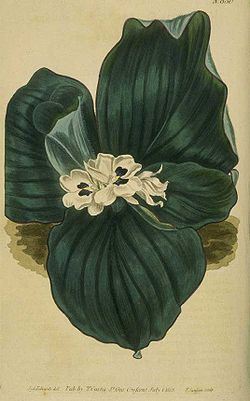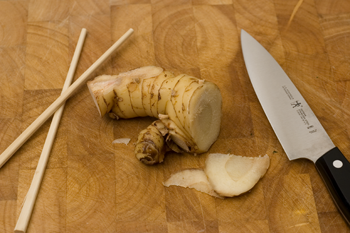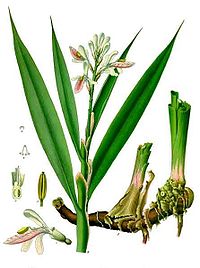
Galangal
Encyclopedia


Rhizome
In botany and dendrology, a rhizome is a characteristically horizontal stem of a plant that is usually found underground, often sending out roots and shoots from its nodes...
of plants of the genus Alpinia
Alpinia
Alpinia is a genus of plants, with more than 230 species from the Ginger family . It is named for Prospero Alpini, a 17th-century Italian botanist who specialized in exotic plants.-Description:...
or Kaempferia in the ginger family Zingiberaceae
Zingiberaceae
Zingiberaceae, or the Ginger family, is a family of flowering plants consisting of aromatic perennial herbs with creeping horizontal or tuberous rhizomes, comprising ca. 52 genera and more than 1300 species, distributed throughout tropical Africa, Asia, and the Americas.Many species are important...
, with culinary and medicinal uses originated from Indonesia
Indonesia
Indonesia , officially the Republic of Indonesia , is a country in Southeast Asia and Oceania. Indonesia is an archipelago comprising approximately 13,000 islands. It has 33 provinces with over 238 million people, and is the world's fourth most populous country. Indonesia is a republic, with an...
. (Lao
Lao language
Lao or Laotian is a tonal language of the Tai–Kadai language family. It is the official language of Laos, and also spoken in the northeast of Thailand, where it is usually referred to as the Isan language. Being the primary language of the Lao people, Lao is also an important second language for...
: ຂ່າ "kha"; "kha"; Malay: lengkuas (Alpinia galanga); traditional Mandarin: 南薑 or 高良薑; simplified Mandarin: 南姜 or 高良姜; Cantonese: lam keong, 藍薑; Vietnamese: riềng).
It is used in various Asian cuisines (for example in Thai and Lao tom yum
Tom yum
Tom yum or tom yam is the name for a spicy clear soup typical in Laos and Thailand. Tom yum is widely served in neighboring countries such as Malaysia, Singapore, and Indonesia, and has been popularized around the world...
and tom kha gai
Tom kha gai
Tom kha gai or Tom kha kai , literally "chicken galangal soup") is a spicy hot soup in Lao cuisine and Thai cuisine. This soup is made with coconut milk, galangal, lemon grass and chicken. The fried chillies add a smoky flavor as well as texture, color and heat, but not so much that it overwhelms...
soups, Vietnamese Huế
Hue
Hue is one of the main properties of a color, defined technically , as "the degree to which a stimulus can be describedas similar to or different from stimuli that are described as red, green, blue, and yellow,"...
cuisine (tre) and throughout Indonesian cuisine, for example, in soto
Soto (food)
Soto, sroto, tauto or coto is a common dish, found in many regional variations of Indonesian cuisine. It is a traditional soup mainly composed of broth, meat and vegetables. There is no clear definition of what makes a soto, but normally many traditional soups are called soto, whereas foreign and...
). Though it is related to and resembles ginger, there is little similarity in taste.
In its raw form, galangal has a citrusy, piney, earthy aroma, with hints of cedar and soap (saponins) in the flavor; its flavor is a complement to its relative ginger, but galangal has little of the peppery heat that raw ginger has. It is available as a whole rhizome, cut or powdered. The whole fresh rhizome is very hard, and slicing it requires a sharp knife. A mixture of galangal and lime juice is used as a tonic in parts of Southeast Asia. In the Indonesian language
Indonesian language
Indonesian is the official language of Indonesia. Indonesian is a normative form of the Riau Islands dialect of Malay, an Austronesian language which has been used as a lingua franca in the Indonesian archipelago for centuries....
, greater galangal is called lengkuas or and lesser galangal
Lesser galangal
Alpinia officinarum, known as lesser galangal, is a plant in the ginger family, cultivated in Southeast Asia. It originated in China, where its name ultimately derives. It can grow several feet high, with long leaves and reddish-white flowers. The rhizomes, known as galangal, are valued for their...
is called kencur. It is also known as galanggal, and somewhat confusingly galingale, which is also the name for several plants of the unrelated Cyperus
Cyperus
Cyperus is a large genus of about 600 species of sedges, distributed throughout all continents in both tropical and temperate regions. They are annual or perennial plants, mostly aquatic and growing in still or slow-moving water up to 0.5 m deep. The species vary greatly in size, with small species...
genus
Genus
In biology, a genus is a low-level taxonomic rank used in the biological classification of living and fossil organisms, which is an example of definition by genus and differentia...
of sedge
Cyperaceae
Cyperaceae are a family of monocotyledonous graminoid flowering plants known as sedges, which superficially resemble grasses or rushes. The family is large, with some 5,500 species described in about 109 genera. These species are widely distributed, with the centers of diversity for the group...
s (also with aromatic rhizomes). In Thai language
Thai language
Thai , also known as Central Thai and Siamese, is the national and official language of Thailand and the native language of the Thai people, Thailand's dominant ethnic group. Thai is a member of the Tai group of the Tai–Kadai language family. Historical linguists have been unable to definitively...
, greater galangal is called "ข่า" (kha) or "ข่าใหญ่" (kha yai), while lesser galangal is called "ข่าตาแดง" (kha ta daeng). In Vietnamese, greater galângl is called riềng nếp and lesser galangal is called riềng thuốc.
The word galangal, or its variant galanga, in common usage can refer to four plant species all in the Zingiberaceae
Zingiberaceae
Zingiberaceae, or the Ginger family, is a family of flowering plants consisting of aromatic perennial herbs with creeping horizontal or tuberous rhizomes, comprising ca. 52 genera and more than 1300 species, distributed throughout tropical Africa, Asia, and the Americas.Many species are important...
(ginger family):
- Alpinia galanga or greater galangal
- Alpinia officinarum or lesser galangal
- Kaempferia galangaKaempferia galangaKaempferia galanga, commonly known as kencur, aromatic ginger, sand ginger, cutcherry or resurrection lily, is a monocotyledonous plant in the ginger family. It is found primarily in open areas in Indonesia, southern China, Taiwan, Cambodia and India, but is also widely cultivated throughout...
, also called kencur, aromatic ginger or sand ginger - Boesenbergia pandurata, also called Chinese ginger or fingerroot
Alpinia galanga is also known as chewing John, little John chew and galanga root. It is used in African-American folk medicine
Folk medicine
-Description:Refers to healing practices and ideas of body physiology and health preservation known to a limited segment of the population in a culture, transmitted informally as general knowledge, and practiced or applied by anyone in the culture having prior experience.All cultures and societies...
and hoodoo folk magic.
Polish vodka Zoladkowa Gorzka is flavoured with galanga.
The rhizome of Alpinia galanga has shown antimalarial activity in mice.
External links


